Andrew Ng: Building Faster with AI
Summary:
Andrew Ng emphasizes that execution speed is a critical predictor of startup success, significantly enhanced by AI. He outlines four key strategies for building faster with AI:
- Work on Concrete Ideas: Define product ideas with enough detail for engineers to build quickly, allowing for rapid validation or invalidation.
- Rapid Engineering with AI Coding Assistants: AI tools drastically reduce the time and cost of building prototypes, enabling systematic innovation through numerous experiments.
- Rapid Feedback: Develop tactics for quickly gathering user feedback, shifting the bottleneck from engineering to product management and decision-making.
- Deep Understanding of AI Technology: Technical knowledge of AI is a key differentiator, helping teams make correct architectural choices and avoid time-consuming blind alleys.
These principles enable startups to navigate the evolving AI landscape efficiently and build impactful applications.
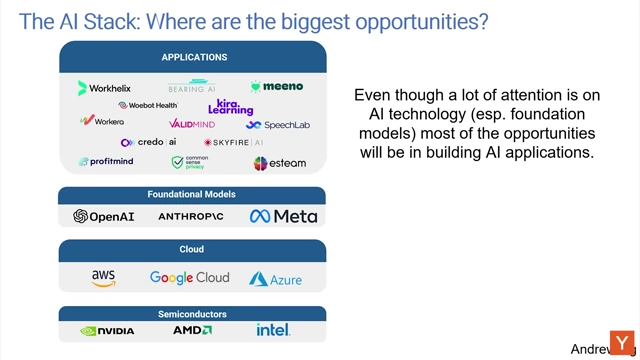
The AI Stack highlights the Applications layer as having the biggest opportunities. [ 00:01:50 ]
Introduction [00:00]
Andrew Ng shares lessons on building startups at AI Fund, a venture studio that co-founds about one startup per month. The focus is on the theme of speed and how changing AI technology enables faster execution.
The Importance of Speed in Startups [00:31]
- Execution speed is a strong predictor of a startup's success.
- New AI technology significantly accelerates startup development.
- Best practices for achieving speed are constantly evolving (every 2-3 months).
Opportunities in the AI Stack [01:13]
- The AI stack comprises several layers:
- Semiconductors: (e.g., NVIDIA, AMD, Intel)
- Cloud: (e.g., AWS, Google Cloud, Azure)
- Foundational Models: (e.g., OpenAI, Anthropic, Meta)
- Applications: (e.g., Workato, MosiacML, Inworld AI)

The AI Stack highlights the Applications layer as having the biggest opportunities. [ 00:01:50 ]
- The biggest opportunities for startups are at the application layer.
- Applications generate revenue that supports the lower technology layers.
- While much PR focuses on foundational models, applications are where the primary value is created.
- A new agentic orchestration layer has emerged (e.g., LangChain, AutoGen).
- This layer helps application builders coordinate calls to underlying technology layers, making application development easier.
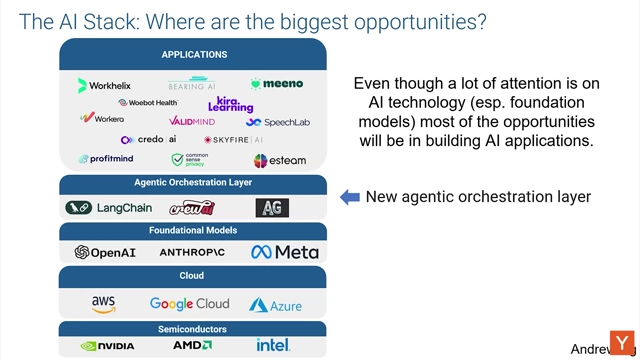
The updated AI Stack, including a new Agentic Orchestration Layer. [ 00:04:30 ]
- This layer helps application builders coordinate calls to underlying technology layers, making application development easier.
The Rise of Agent AI [02:06]
- Agentic AI is the most important tech trend in AI.
- Non-agentic workflow (zero-shot): Asking an LLM to generate a complete output in one go, like typing an essay from start to finish without backspace. This is not how humans or AI perform best.
- Agentic workflow: An iterative process where the AI performs tasks in steps (e.g., outline, research, first draft, critique, revise).
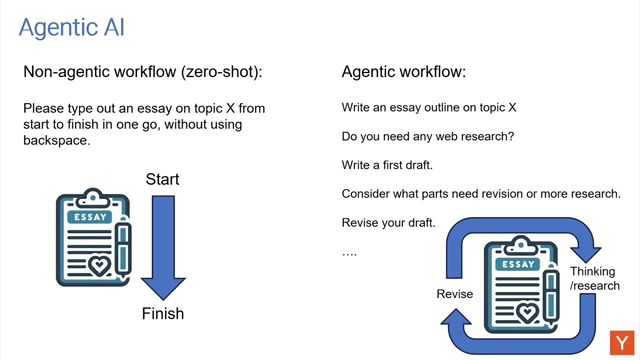
Comparison of Non-agentic and Agentic AI workflows, showing the iterative nature of the latter. [ 00:03:40 ] - This iterative loop, though slower per step, delivers a much better work product.
- Agentic workflows are crucial for complex tasks like compliance document analysis, medical diagnosis, and legal document reasoning.
- Many valuable businesses will be built by implementing existing or new workflows into agentic AI systems.
Concrete Ideas for Faster Execution [04:52]
- Work only on concrete ideas to gain speed.
- A concrete product idea is specified in enough detail for an engineer to build it.
- Example of Not Concrete: "Use AI to optimize healthcare assets." (Too vague, leads to different interpretations).
- Example of Concrete: "Software for hospitals to let patients book MRI machine slots online to optimize usage." (Clear, buildable).
- Example of Not Concrete: "AI for email personal productivity."
- Example of Concrete: "Gmail-integrated automation that lets users write prompts to automatically filter/tag emails."
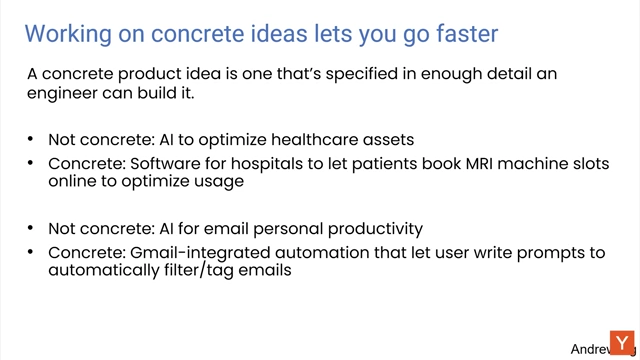
Examples of Concrete vs. Non-Concrete Product Ideas. [ 00:06:00 ]
- Vague ideas often receive praise but cannot be built quickly, hindering speed.
- Concrete ideas provide clear direction, allowing for rapid validation or falsification.
- A concrete product idea is specified in enough detail for an engineer to build it.
- Tips for working with concrete ideas:
- Good concrete ideas often come from subject matter experts who have thought about a problem for a long time. Their "gut" decisions can be surprisingly effective for rapid decision-making, faster than data collection for new startups.
- Focus on a single, clear hypothesis. Startups lack resources to pursue many ideas simultaneously.
- If data indicates an idea is failing, pivot quickly to a new concrete idea.
- Frequent pivoting might suggest insufficient initial knowledge about the sector.
Rapid Prototyping and Engineering [08:56]
- The build/feedback loop is critical for driving customer acceptance.
- This involves building software (engineering), getting user feedback (product management), and iterating.
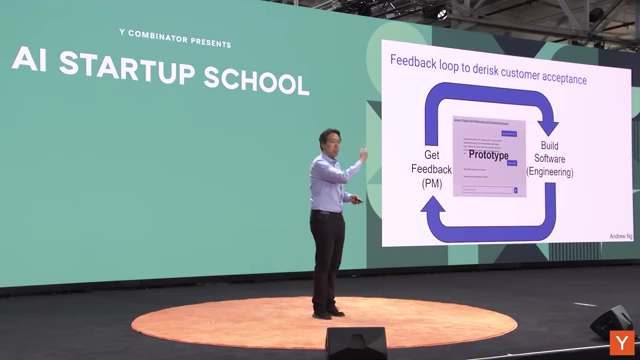
The Build/Feedback Loop illustrating iterative product development. [ 00:09:40 ]
- This involves building software (engineering), getting user feedback (product management), and iterating.
- AI coding assistants enable rapid engineering:
- Building prototypes: AI makes this 10x faster (or more).
- Lower requirements for integration with legacy systems, reliability, scalability, and even security for internal testing.
- Allows systematic pursuit of innovations by building many prototypes to see what works.
- The mantra should be "move fast and be responsible," rather than "move fast and break things."
- Writing/maintaining production software: AI makes this 30-50% faster (less dramatic than prototyping, but still significant).
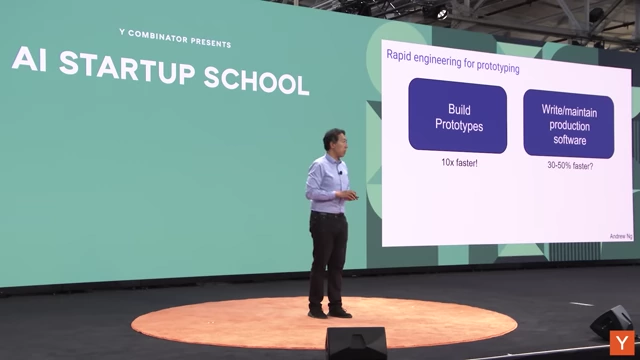
Speed improvements in engineering: 10x faster for prototypes vs. 30-50% for production software with AI assistants. [ 00:10:50 ]
- Building prototypes: AI makes this 10x faster (or more).
- New philosophies in software engineering:
- Code is less valuable as an artifact; entire codebases can be rebuilt quickly.
- Architectural decisions, previously "one-way doors," are now more like "two-way doors" due to reduced costs of re-engineering.
- Evolution of AI assistance:
- Code autocomplete (e.g., GitHub Copilot)
- AI-enabled IDEs (e.g., Cursor, WindoWs)
- Highly agentic coding assistants (e.g., Claude Code, Cody)
- Staying on top of the latest tools is crucial for developer productivity.
- Empowering everyone to build with AI [14:30]:
- Advising people not to learn coding because "AI will automate it" is bad advice.
- Historically, making coding easier (e.g., keyboards over punch cards, high-level languages over assembly, IDEs over text editors) has led to more people learning to code.
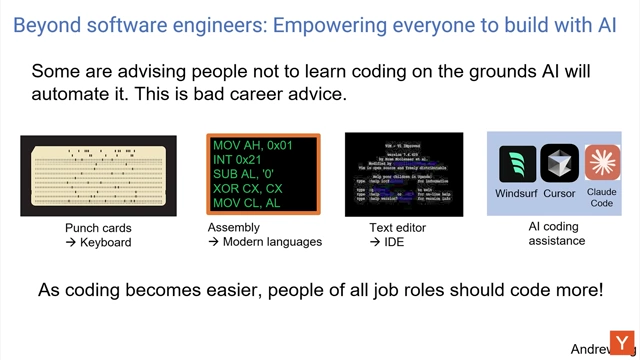
The evolution of coding tools, from punch cards to AI coding assistants, emphasizing increased accessibility. [ 00:15:20 ] - Andrew Ng advocates for everyone, regardless of job role (CFOs, HR, marketers), to learn to code to enhance productivity.
- The ability to tell a computer exactly what you want (even by steering AI to code for you) will be a critical skill.
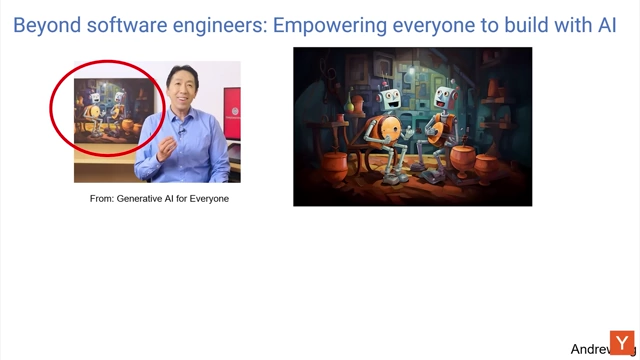
Example of AI-generated robot art, demonstrating precise control with detailed prompts. [ 00:16:12 ]
The Role of Product Management [17:06]
- With engineering becoming faster, product management (getting user feedback, deciding features) is now the bottleneck.
- Changing PM:Engineer ratios: Traditionally 1 PM to 4-7 engineers; now teams propose ratios like 1 PM to 0.5 engineers due to increased engineering speed.
- PMs who can code, or engineers with product instincts, tend to perform better.
- Where to get product feedback (from fastest/less accurate to slowest/more accurate):
- Play with the product yourself (30 min). If you're a subject matter expert, your gut can be surprisingly good.
- Ask 3 friends or teammates (30 min - 4-5 calls).
- Ask 3-10 strangers (1 day). Learn to spot high-foot-traffic areas (coffee shops, hotel lobbies) to respectfully ask for feedback.
- Send prototypes to 100 testers (1 week).
- Send prototypes to 1,000 users to get qualitative or quantitative feedback (1-2 weeks).
- Launch full-fledged product, A/B test (2+ months).
- A/B testing, while valuable, is often the slowest tactic.
- It's crucial to analyze data from feedback loops to hone instincts and update mental models of users, improving the speed and quality of future product decisions.
The Value of Understanding AI [21:23]
- A deep understanding of AI is a differentiator because AI is an emerging technology.
- For mature technologies (like mobile apps) and job roles (sales, marketing, HR), knowledge is widespread.
- For AI, the knowledge of how to do it well is not yet diffuse.
- Making the right technical choices (e.g., chatbot accuracy, prompting vs. fine-tuning, achieving low latency for voice apps) saves immense time.
- A wrong technical decision can lead to months of chasing blind alleys, multiplying development time far beyond a theoretical 2x slowdown.
Leveraging Gen AI Tools for Startups [23:26]
- A vast array of GenAI building blocks has emerged in the past two years:
- Prompting, agentic workflows, evals, guardrails, RAG, voice stack, async programming, data extraction, embeddings/vectorDBs, fine-tuning, graphDBs, LLMs, agentic browsers/computer use, MOP reasoning models.
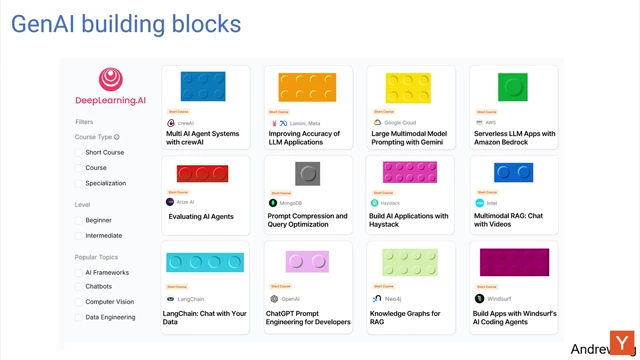
Various GenAI building blocks presented as colorful LEGO bricks, illustrating their combinatorial potential. [ 00:25:19 ]
- Prompting, agentic workflows, evals, guardrails, RAG, voice stack, async programming, data extraction, embeddings/vectorDBs, fine-tuning, graphDBs, LLMs, agentic browsers/computer use, MOP reasoning models.
- These blocks can be combined to build software previously impossible even a year ago.
- Analogy of LEGO bricks: Knowing more building blocks (different colors, shapes) allows for combinatorially (exponentially) richer and more complex creations.
- Learning these building blocks (e.g., through DeepLearning.AI courses) directly translates to the ability to combine them into novel applications.
- Flexibility in model choice: The switching cost for foundation models is relatively low.
- Teams should architect software to make switching between different building block providers easy (e.g., using evaluation metrics to automatically switch to better models).
- Preserving this flexibility enables faster development even when building complex, multi-layered applications.
Conclusion: Building at Speed with AI [25:26]
- While many factors contribute to startup success, execution speed is highly correlated.
- Strategies to achieve speed:
- Work on concrete ideas.
- Leverage rapid engineering with AI coding assistance.
- Implement rapid feedback mechanisms.
- Cultivate a deep understanding of AI technology.
- Entrepreneurs should develop the skill of seeking rapid, respectful feedback from diverse users, even strangers, to hone their product instincts.
Addressing AI Hype and Misconceptions [26:41]
- AI hype narratives have been amplified for promotional, fundraising, and influence purposes.
- Examples of overhyped narratives: AI leading to human extinction, AI automating all jobs, new models wiping out thousands of startups, nuclear power being the only viable energy for AI. These are distortions.
- AI Safety vs. Responsible AI [30:23]:
- AI is a tool, neither inherently safe nor unsafe; its safety depends on how it is applied.
- The term "AI safety" is misleading; "responsible AI" is more appropriate, focusing on how humans use AI ethically.
- Sensationalized media reports often exaggerate lab experiments, contributing to misinformation.
AI in Education: Current Trends and Future Directions [37:35]
- Two main paradigms for AI in education:
- AI making teachers more productive (automating grading, homework).
- AI providing personal tutors for every student.
- While everyone feels change is coming, widespread disruption is not yet here.
- Many teams are experimenting (e.g., Coursera Coach, DeepLearning.AI chatbots, language learning apps like Duolingo).
- Education will likely become hyper-personalized.
- The exact workflows (e.g., avatar tutors vs. text chatbots) are still evolving; the "end state" is not yet clear.
- The reality is that complex human workflows (teachers, students) require careful mapping to agentic AI, a process still underway.
Balancing AI Innovation with Ethical Considerations [39:33]
- Ethical judgment: If a product does not fundamentally make people better off, it should not be built.
- AI Fund has killed projects on ethical grounds, even when economically viable.
- Economic inequality:
- People in non-engineering roles are significantly more productive if they understand and can use AI.
- Empowering everyone to build with AI is crucial to prevent widening inequality.
Protecting Open Source and the Future of AI [41:27]
- Threat of Gatekeepers: The danger is not AI itself, but certain businesses using "dangers of AI" narratives to push for regulations that would centralize power.
- Similar to mobile ecosystems (Android, iOS) where two gatekeepers restrict innovation.
- Example: Proposed California bill SB 1047, which would have imposed burdensome regulatory requirements, making it difficult to release open-source and open-weight AI software.
- Protecting Open Source: This fight is crucial to prevent innovation from being stifled and to ensure the diffusion of AI knowledge, allowing many startups to build responsibly.